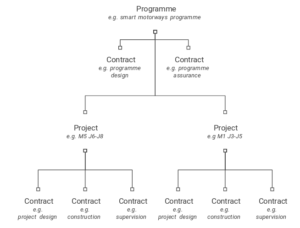The #OC4IDS: A new standard for infrastructure transparency

When you think infrastructure, it’s easy to get into superlatives. Trillions of dollars are spent. We’re talking an estimated $97.5 trillion in infrastructure investments that are needed to meet the Sustainable Development Goals by 2040, according to numbers by the Global Infrastructure Hub.
Roads, railways, airports, water distribution, schools, and hospitals: infrastructure is the foundation for how we live our lives.
But there is also a huge efficiency gap (approximately 30%, according to the IMF) between the money that is spent and the coverage and quality of the resulting infrastructure. This means that vital, life-changing infrastructure is not being delivered to citizens.
You wouldn’t imagine building a bridge without a detailed blueprint. But it seems that’s how infrastructure is financed and procured. Information about the project, contracts and monies involved is scattered among budget, project management, and procurement systems. It is obscure, and often simply not available to all of the actors involved.
Underpinning these issues is the very nature of the infrastructure and the construction industry – large sums, long timelines, complex supply chains – all of which increase the risk of losses from inefficiency, mismanagement or corruption. The recent Odebrecht and Carillion scandals made evident that we need more, better and more timely data across the process to make sure public works deliver. This is where open contracting can help.
In the past, monitoring infrastructure projects has been a document-driven process, periodically gathering information on a handful of the active projects, and carrying out review and validation activities to produce a report on each project. We’ve had a deep look into the information available in Honduras, the UK and Ukraine and scanned other approaches to identifying & monitoring infrastructure projects around the world. What we discovered is that data is available. But it is scattered and disconnected.
We might first seek a one-to-one relationship between a major project and a contract that delivers it: but this rarely exists in reality. In practice, depending on your jurisdiction, most infrastructure projects are more complex and involve at least three main contracts (Design, Build and Supervision/monitoring) and multiple subcontracts.

This is why we proudly present the new Open Contracting for Infrastructure Data Standard #OC4IDS. A joint effort by CoST – the Infrastructure Transparency Initiative and the Open Contracting Partnership, it builds on best practice in open data and openness of public infrastructure procurement globally.
It connects previously siloed information to better publish and track infrastructure investment and delivery. The #OC4IDS provides clear guidance to governments on what information to disclose and more importantly how to disclose, at each stage of an infrastructure project. This will help ensure public money is spent well from inception to completion, and in the future, potentially operation, maintenance and beyond.
It provides information at
- the project level, which moves through identification, preparation, implementation and completion phases – with important items to disclose at each point;
- the contracting summary level – which captures key information about the contracts that deliver design, construction and supervision;
- the contract process detail level – where each update and variation to a contract can be monitored, and justifications and explanations for change sought.
And the best part: This transforms cumbersome, paper-based processes into machine-readable, interoperable, open data to unlock efficiencies, enhance competition and deliver better value for money. Better data across the project cycle will open opportunities for citizens, civil society and journalists to hold officials accountable and build better infrastructure for all.
This is already starting to happen. In Honduras, the SISOCS platform now hosts data on over a thousand transport and other infrastructure projects. Backed by legal reforms that mandate disclosure, the platform is regularly updated by government agencies with project and contract details as well as original documents and photos related to their infrastructure projects and captures detailed data points including contract values, locations, and suppliers. In Ukraine, the national CoST Secretariat has created a similar platform, replacing spreadsheet-based reporting with a central online tool. This platform intends to draw on data in an Open Contracting Data Standard (OCDS) format from the award-winning Prozorro portal.
Although these models currently require some manual entry of information, the #OC4IDS makes it possible to directly import information on tender, award and contract stages from existing procurement or other monitoring systems. This also means limitless potential for joining up data across agencies, departments and functions to enable better coordination and efficiency in addition to whole lifecycle transparency. Fully implemented, this will greatly reduce administrative burdens, saving time and money!
The shift from document-driven to data-driven oversight is not just a change in scale. We anticipate it also involves a shift in the emphasis of reporting and oversight. For example, whilst a document-driven process might periodically review contract changes, and provide a narrative justification – in a data-driven process drawing on live systems, variations could be captured on a week-by-week basis. Instead of producing deep and detailed narrative reports on a handful of projects, a data-driven approach may provide an overview of hundreds or thousands of projects, enabling selection of a targeted few for the deep-dive exploration.
We are excited to add this essential tool to our portfolio. We know that keeping track of infrastructure projects can be challenging. Reach out to learn more about different intervention models and join others in implementing it.
Superlatives should be used with caution. But we believe that this new standard could truly be a game-changer.
Photo: Peter L. Higgs, Temburong Bridge construction project